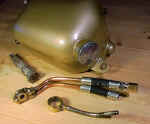| OIL Pump, Tank, Filter & Pipes |
"Check your pump", I read somewhere. Good idea, as it is maybe the most important part in regard to what expensive damage can be done by a failure. A good insurance is to regularly check for a healthy oil return flow in the tank before driving away. This denotes that the pump is doing fine. But it feels good to check the pump itself, looking for wear, cracks, loose screws etc. The material used is some zink compound, definitely not meant for daily dismantling. Do not use force if you open it for inspection & cleaning, being very careful with the threads while reassembling. Turn the drive spindle with a finger, it should revolve evenly & freely. An oilpump problem can (in addition to demolishing your engine) be a cause of wet sumping, oil filling up the crankcase when the machine is not in use. This A10 uses Pennzoil monograde 40. Have tried 10w40 & 20w40 of different types & brands, but always went back to the monograde. Unless one lives among eskimos there will be no harm done by using 30 or 40 monograde, or even 50 in warm climate. This will make the normal small oil leaks much less of a problem. And remember the engine was originally designed for monogrades. After performing an overhaul I use 20-w50, see the oil page. Don't save on oil, change it every 1000 miles. The long term benefits can be of great value. |
|
Can be done by removing 3 nuts & the two
lower studs (carefully, do not destroy threads). This makes it possible to get the pump
out without having to disturb the crankshaft driving pinion. To prevent all the oil
spilling out you can plug the feed holes while working, or do the work in conjunction with
an oil change. Check or change the gasket at the back of the pump, & remember the
small gasket at the front stud or you may bend the pump's housing when tightening the nut.
After refitting watch for a good spray of oil returning to the oiltank & drive with
confidence. |
|
|


